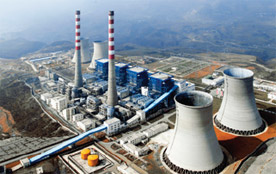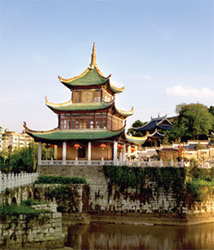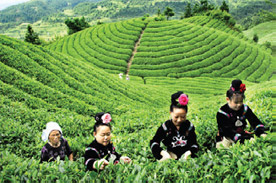 5. Medical herbs 5. Medical herbsGuizhou is one of the four largest Chinese-herbsproducing regions. In 2013 the cultivation area for medical herbs reached 29,866 hectares, and reaped a production value of US$2.6bn. There are now nine medical herb-growing zones and seven medical herb-processing parks. Among the nation’s top 500 pharmaceutical enterprises, 14 come from Guizhou. Five enterprises have gone public, which is 23 per cent of the province’s total listed companies. Herb cultivating areas will reach 40,000 hectares in 2017, and the production value of medical herbs will grow from US$2.6bn to US$4.2bn. Meanwhile, the total production value of pharmaceuticals will grow from US$4.9bn to US$13bn. 7 New Industries  1. Energy 1. EnergyCoal and water resources are abundant in Guizhou, an advantage for the power generating industry. In 2013 electricity generation registered a capacity of 44.8 million kilowatts. The province’s twelfth five year plan aims at a total production value of US$24.4bn for the energy industry and total investment will reach US$65bn. 2. Modern logistics Added value of the province’s logistics industry rose 1.61 times from 2010 to US$15.4bn in 2013. The completion of the Sichuan-Guizhou railway and Guizhou-Guangxi railway has laid the foundation for a sophisticated high-speed transportation network.  3. Speciality farming 3. Speciality farmingSituated in highland areas and with a suitable climate, Guizhou is rich in livestock in terms of species and variety. There is a wealth of famous, high-quality, rare and precious species for the development of speciality industry. 4. Mining Guizhou is rich in mineral resources and the mining industry is flourishing to become a pillar economic sector that shares more than 30 per cent of the province’s total industrial value. Guizhou is one of the country’s top 10 in non-ferrous metal reserves. It is also the country’s most important base for the aluminium, phosphorous chemistry and manganese-iron alloy industries, and Asia’s largest barium carbonate production base.  5. Tourism resources exploitation 5. Tourism resources exploitationGuizhou’s natural resources and ethnic culture are treasures yet to be exploited. The province has a well-formed Karst topography and well-preserved ethnic culture that means more than a thousand spots which can be developed into tourist sites. There are also over a thousand villages and rural area that might be turned into tourist attractions. 6. E-commerce In 2014 Guiyang city was honoured with the title of “national demonstration city for e-commerce”, and “national pilot city for e-commerce and logistics co-ordination”. In 2012 the Guiyang Economic Technology Development Zone became one of the first national demonstration bases for e-commerce. The province recorded a trading value of US$5.3bn from e-commerce in 2013. Guizhou’s e-commerce platform(http://www.gogbuy.com) radiates to the whole country, and with the formation of an e-commerce ecology circle a complete chain for the industry will further enhance competitiveness in regional economy.  7. High and new technology 7. High and new technologyThe country has been supporting Guizhou’s technological development with ever increasing efforts. Innovation initiated developments in high and new technology saw the province “reaching for the cloud”. Smart information technology has led the province to the “mega data” era. With “e-government cloud”, “industry cloud”, “intelligent traffic cloud”, “food safety cloud”, “e-commerce cloud”, “environmental protection cloud”, “smart tourism cloud” and the so-called “7+N” cloud engineering projects in place, data and information in every level of the government will be integrated and shared through the cloud application platform. As a result, the province leads the country to set up a demonstration zone for mega data integration, application and development.
For more information, please contact: |










